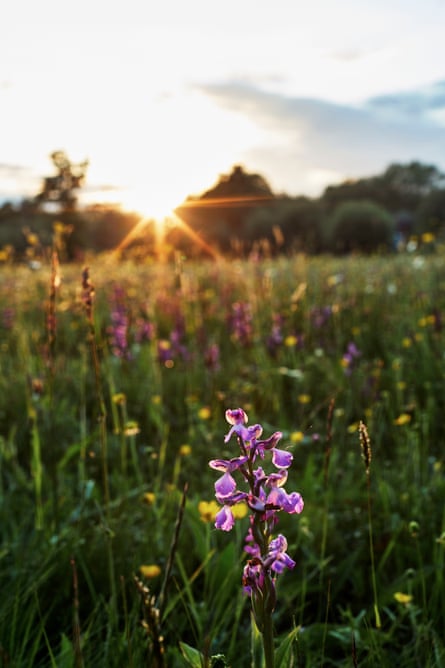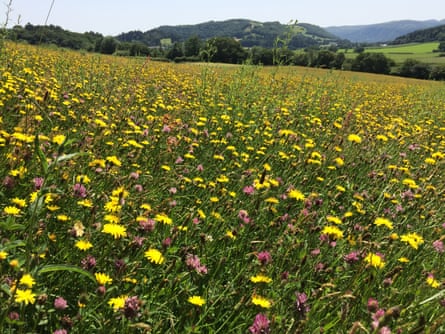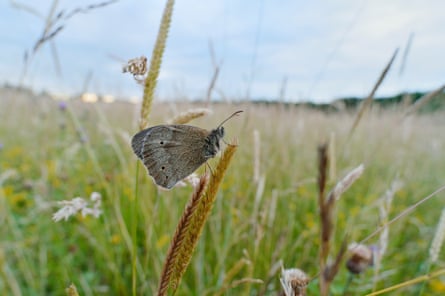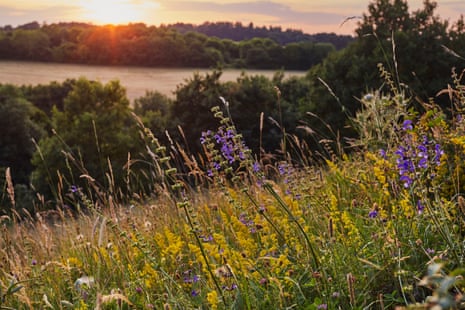On a perfect summer day, the bees drone and a million flowers dance as a dozen people move across the meadow, cutting hay with a rhythmic swish of scythes. As children play, the haymakers pause for refreshments of cake and cider.
This would resemble a scene from a long-lost rural idyll if the scythes were not Austrian carbon-steel and the children were not identifying flowers on smartphones. After a century in which more than 97% of Britain’s wildflower-rich meadows were destroyed, meadowland is making a comeback.
The miraculous properties of meadows – and even, improbably, cutting them with scythes – are being cherished again. The charity Plantlife has led the creation of 5,000 hectares (12,000 acres) of wildflower-rich meadows since 2013 – including 90 meadows to mark the 60th anniversary of the Queen’s coronation, in a campaign initiated by Prince Charles. Scores of grassroots meadow groups have also sprung up, inspired by everything from Poldark’s scything scenes to books by the Cumbrian hill farmer James Rebanks and the West Sussex landowner Isabella Tree. Wildflowers are returning to not just rural, but urban communities. And this year, the government’s Green Recovery Fund will create another 500 hectares of meadows, with trainee “meadow makers” learning the skills of meadow maintenance.

Even Trevor Dines, Plantlife’s botanical specialist, was taken by surprise when he created his own meadow on a small field he bought near his home in north Wales in 2015. The field had been what farmers traditionally describe as “improved” – its grass fertilised and grazed so intensively that delicate wildflowers disappeared. The field had about 20 species of plant. (Many intensively farmed grass fields are now sown with just one rye-grass species.) Dines stripped off this sward to expose the soil and spread fresh hay containing local wildflower seeds from a flower-rich meadow six miles away. This “natural seeding” technique has been a key principle of the coronation meadows, of which his is one.
Dines cut the grass once a year in late summer and removed the cuttings, because if cut grass is left on the fields, it cycles nutrients back into the soil, and nutrient-rich soils mean that aggressive grass species smother more delicate wildflowers. Then, last spring, Dines sat down to record what was there: 98 species of plant and, on a single day in late May, 2m individual flowers. They produced, he calculated, 1kg of nectar-sugar a day, which could support 83,000 bees. “The transformation has been absolutely astonishing,” he says. “I don’t think people appreciate the bags of sugar being produced in these fields.”
Meadows are, as Dines puts it, “crucibles” of biodiversity. Up to 40 plant species are found in a square metre of chalk downland meadow. These plants support a tumult of other life; a typical suite of meadow plants provides food for 1,400 invertebrate species. “Pollinators such as bees are really important, but it’s the aphids, thrips, grasshoppers, bugs and beetles living on plant matter, that’s the real powerhouse of biodiversity in these areas.”
Meadows are crucial sanctuaries during an extinction crisis, but also offer numerous practical benefits. For a start, they are better for livestock health. If livestock eat species-rich meadow grass, they take in natural herbal medicines, such as bird’s foot trefoil, which reduces gut parasites. (Bird’s foot trefoil also supports 150 invertebrate species.) More diverse meadows supply more minerals too. “We’re giving our livestock a really nice varied diet, which is what they want,” says Dines.
The name “water meadow” gives a clue to another practical function: valley-bottom meadows hold flood water (and new estates – often named after the meadows they destroy – have been foolishly built on them). And, Dines says, meadows excel at storing carbon; grasslands in Britain store more carbon than any other habitat. “What’s really exciting is that the biggest levels of carbon sequestration happen when you convert an arable field into a species-rich pasture,” says Dines. Once established, a meadow is a stable store of carbon; plough it up, and the carbon is released.
Helen Baczkowska of Norfolk Wildlife Trust is another meadow maker. Working with farmers, she is restoring lost meadows by re-seeding them with hay from roadside verges, virtually the last sanctuary for wildflowers in parts of lowland Britain.
Meadows were celebrated by the Romantics. “Among the meadows hay cocks / ’Tis beautiful to lie / When pleasantly the day looks / And gold like is the sky,” wrote the rural poet John Clare in the 1800s. Their destruction is often blamed on the “dig for victory” campaign during the second world war, but the loss, says Baczkowska, was because meadows ceased to have an economic function. “For a long time grasslands were really needed to feed cattle and working horses on mixed farms in winter,” she says. Since the 30s, farms have fed grain to their livestock and, of course, moved away from horse power. “Even those meadows that weren’t ploughed up became in very poor condition because there was no incentive to manage them,” she says.

During the second half of the 20th century and into this one, the destruction of meadows quietly continued. Now, however, Baczkowska sees a new awakening to their beauty and importance, and believes this has intensified since the start of the pandemic. “I’ve seen a real change in the last 10 years. People are looking more and more to what they can do on their local patch. Not just gardens but playing fields, parish grounds and commons. Pollinator strips and wildflower strips are so easy to deliver, and when people marry it with using local seed, that’s great.”
Most meadow-makers buy wildflower seeds for the initial creation. However, Baczkowska explains, commercially produced seed is grown to be harvested on the same day, so new knapweed flowers, for instance, will flower together and go to seed in the same week. Hand-collecting local seed – as Norfolk Wildlife Trust does in partnership with Norfolk Farming and Wildlife Advisory Group, a charity run by farmers – gives meadows a much longer flowering season, making them more useful to pollinators, and more beautiful. “Keeping local seed types going will give you this resilience to climate change. It’s not just the diversity of species; diversity of genetics is really important,” says Baczkowska.
The individuality of different meadows is their strength. On Landseer park, in the heart of urban Ipswich, wildflower-rich chalk banks created by the charity Buglife and an inspiring young conservationist, David Dowding, an Ipswich borough council ranger, are now home to scarce butterflies such as the dark green fritillary. Off the busy A19 between York and Selby is Three Hagges, a “woodmeadow” created in 2012 by Ros Forbes Adam, whose family has farmed the area for 350 years.
Forbes Adam cheerfully admits she “hadn’t a clue” when she began creating what she and her husband originally planned as a new wood on a 10-hectare barley field. She obtained a Forestry Commission grant to plant trees but, crucially, also secured an agreement to make meadows on 40% of the site. What emerged is what ecologists call “wood pasture” or “woodmeadow”, a mosaic of grass and woodland that was once widespread in ancient Britain and still occurs in Scandinavia and eastern Europe.

More than 1,000 invertebrate species have now been recorded, including 34 bee species, 26 butterfly species and 43 hoverfly species – none of which were found on the old barley field. Three Hagges, which is open to the public, has been a sanctuary for people, too: there are school visits and 90 volunteers help manage the site.
“My eureka moment of believing we had done the right thing,” says Forbes Adam, “was when Meg Abu Hamdan, who records butterflies here, told me: ‘When I walk through the gate of Three Hagges, I step into my 25 acres of hope.’ And also when I held my first pygmy shrew, came across wood anemone flowering and saw my first marbled white butterfly.”
Forbes Adam has since created a charity, the Woodmeadow Trust, which is advising more than a dozen other community groups and landowners on woodmeadow projects, from Yorkshire to London. “It’s really exciting that we are starting to inspire other people,” says Forbes Adam. “Our aspiration is a woodmeadow in every parish.”
But can it really be wise to lose productive food-producing fields to flowers? “We have to look at the bigger picture,” argues Forbes Adam. “It brings huge numbers of pollinators to the landscape, which benefit all the neighbouring farmers.”
Some rewilders may scorn this careful “management” for not allowing nature to run free. But Dines points to his results. “I started with a field with hardly any flowers. I’ve got 9m flowers on a summer’s day. Are you going to tell me that’s not rewilding? I’ve put the wild back into that field. Unfortunately I only own a few acres, but if every farmer did one little meadow, we’d soon bring wildlife back.”

Make your own meadow
If you don’t have a garden, join local groups (or your parish council) that manage parks, playing fields, church yards or school grounds. Encourage them to create pollinator strips or allow areas of long grass in summer. Many people still see long grass as untidy, but will be won over if it is filled with flowers and framed by short grass or mown paths.
Any lawn or verge can be rewilded. Some remove turf and top-soil before sowing. Or just scuff up existing sward with a spade and a rake to make space for new seed. I use Emorsgate Seeds for native wildflowers, but if you can find a local seed source, that is even better.
Add native yellow rattle seeds to lawns. The rattle parasitises the grass and enables other wildflowers to grow.
Plantlife urges people to sign up to “No Mow May”. Ideally a wildflower meadow should be cut (with grass cuttings removed) in late summer. But creating a mosaic of long and short grass in a garden is best for diversity. Leave grass cuttings in a sunny corner for grass snakes.
Every Flower Counts. Take part in this plant survey and Plantlife will give you your own personal nectar score, so you can see how many bees your wilder lawn is feeding.
Wildflowers for the Queen: A Visual Celebration of Britain’s Coronation Meadows by Hugo Rittson Thomas will be published by Wildflower Press on 4 February. To buy for £43.50 (RRP £50) go to bookshop.theguardian.com

Comments (…)
Sign in or create your Guardian account to join the discussion